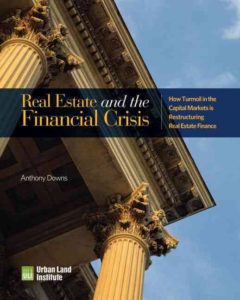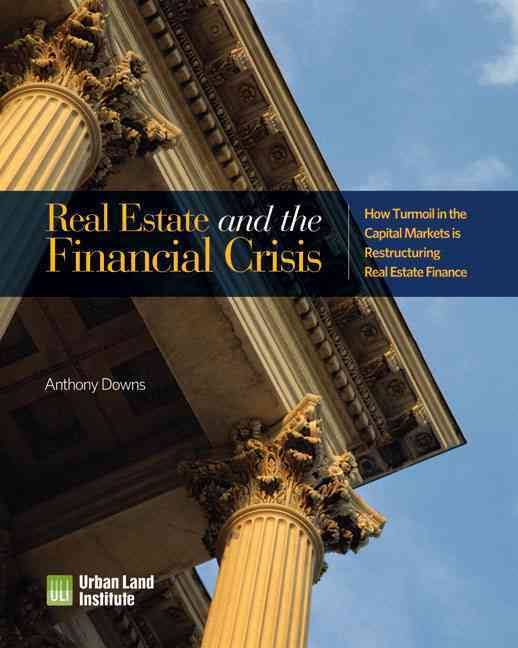Volume 34, Number 2
Summer 2009
Reviewed by Steve Price, CRE

Tony Downs’ 2007 Book Niagara of Capital documented the causes of hyper-liquidity, loose credit and rapid asset appreciation in commercial and residential real estate markets. His new book follows that excellent account with an equally accurate but more forward-looking volume. Real Estate and the Financial Crisis: How Turmoil in the Capital Markets is Restructuring Real Estate Finance was published in April of 2009, but events of the past four months have not dated it. His concerns and scenarios for the future will clearly dog developers and property investors for years to come.
For a readership with little time to spare, Downs’ writing style is wonderful. Excellent organization, clear headings, liberal use of bullet points and well-presented graphics enable one to finish the book in about three hours yet still absorb an enormous amount of information. It is literary efficiency in action.
Many commercial practitioners (myself included) largely ignored the single-family residential market. In this particular crisis, subprime loans really did matter; though if you asked many of us in commercial markets three years ago, we would have been unfamiliar with them. Yet residential for-sale markets have enormous influence on consumption and employment in the national economy. As Downs emphasizes, national financial policies were frequently based upon the assumption that housing prices would always rise, which they did like clockwork each year from 1968–2006.
Downs underscores the importance of Hyman Minsky’s theories of financial instability: optimism; prosperity and easy money spiraling upward in a feedback loop until sheer over-leverage or an outside event causes a pullback in credit; forced assets sales; falling asset prices; and a reduction in economic growth. As Minsky suggests, the more credit and equity available, the greater the speculative sentiment; and the higher the asset prices, the bigger the slowdown. At the same time, it is difficult to plan, forecast or regulate for “down” times when the good times are so strong. After such a crash, Downs emphasizes the risk of inflation resulting from Minsky’s recommended large-scale government intervention.
At the end of the book, Downs describes four distinct scenarios with a probability for each. The second of his scenarios, with a 65 percent probability, looks to be the path we currently are on:
- “Prolonged suspension of real estate credit … well into 2010;”
- Historically high unemployment;
- Banks respond slowly, stay weak and attract little new capital;
- Very few commercial real estate transactions;
- The federal government funds economic stimulus, “aggravating already large federal deficits;”
- Thus, recovery will be slower than other post-World War I recessions.
Much is still in question as to factors that will affect our recovery:
- Will Asian countries start spending within their domestic economies or will they continue to save and bolster their financial reserves in order to ensure stability? The former will mean more U.S. exports, but a higher cost of funds. The latter may mean a replay of the excess capital and low-interest rates of the past decade.
- How will governments balance the demand for increased financial regulation with their role of providing liquidity to the markets?
- How will debt securitization be rebuilt and what mechanisms will ensure trust and transparency?
- So where will we be five to eight years from now?
There will be lower demand for new supplies of owner-occupied single-family units. From 2000–2007, 75 percent of new construction was for-sale units and 25 percent was rental units. From 1960–1989, for-sale units were only at about 55 percent. We can expect a big swing back to multi-family rentals as a proportion of new construction
REITs look well-positioned to reprice, recapitalize and act quickly. There will be no flood of consumer or investor dollars back into retail any time soon. Success in commercial real estate will not be based upon asset creation, transactions and speculation, but on asset management, cost reductions and property improvement.
In the government arena, the pendulum of power and finance has swung away from the states and cities and back to the federal government. States and cities have lost much of their available financing—because of declines in real estate transactions and sales taxes—as well as the ease with which they can issue new debt.
In addition to your own reading, this book is a great recommendation for clients and colleagues.
For more on Minsky, read Manias, Panics, and Crashes: A History of Financial Crises, by Charles P. Kindleberger and Robert Aliber.
For more on scenario planning, try The Art of the Long View: Planning for the Future in an Uncertain World, by Peter Schwartz.






